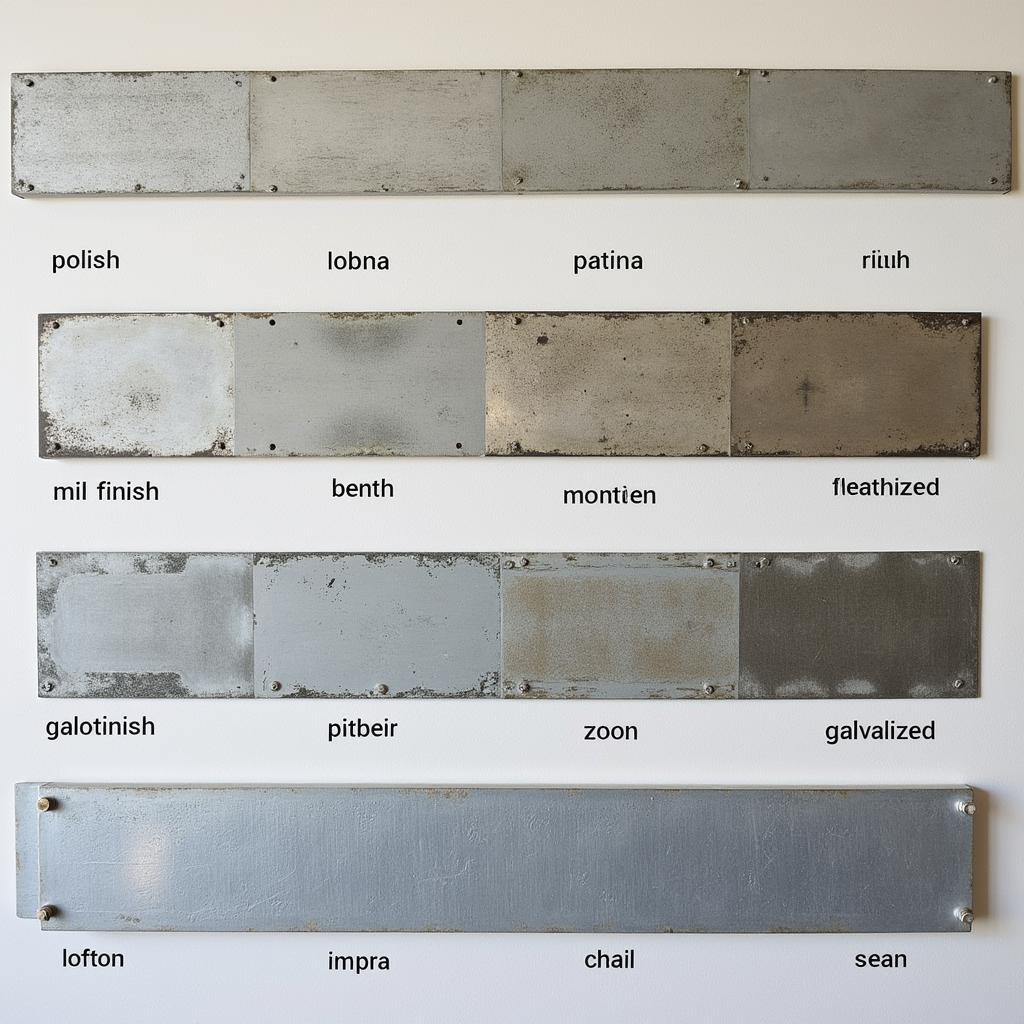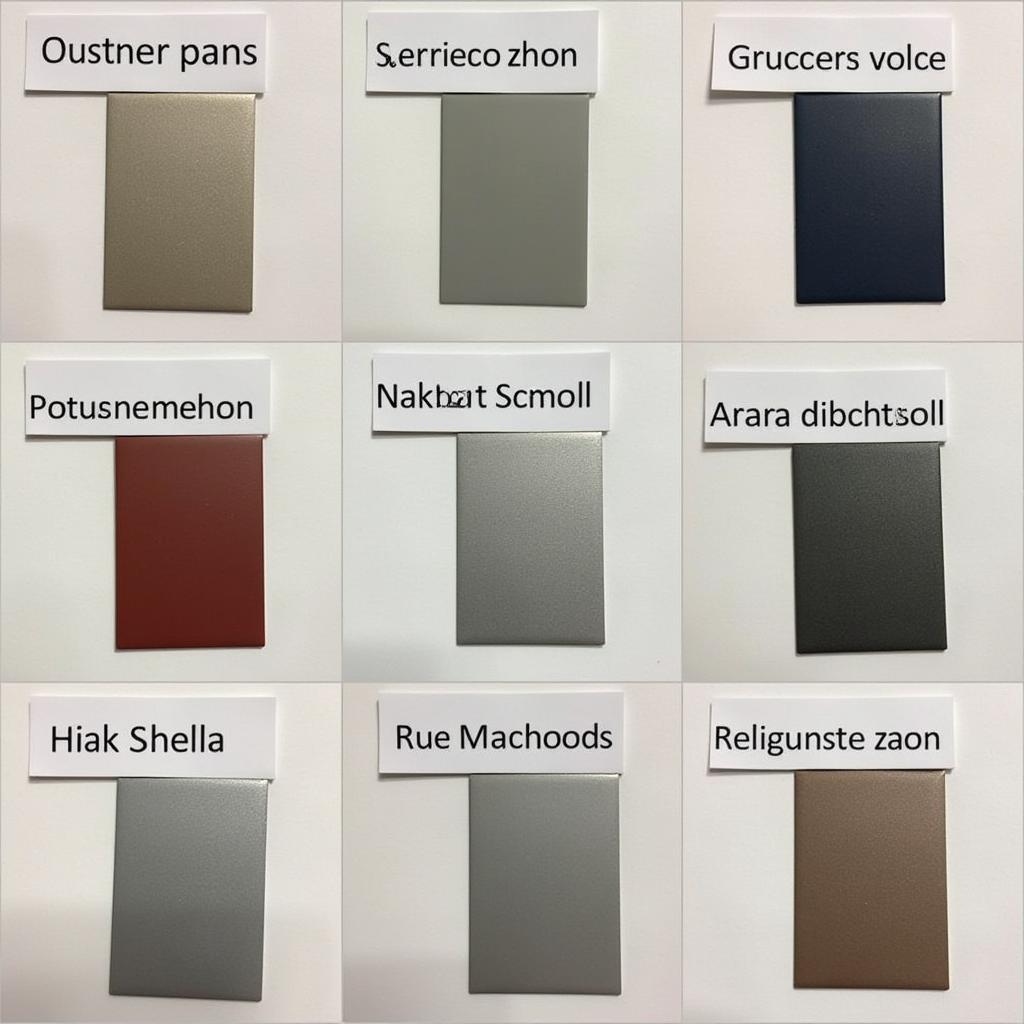Zinc, a versatile metal used in countless applications from construction to nutrition, isn’t typically considered a color in the traditional sense. However, its distinct appearance contributes to a specific aesthetic that can be described as a “zinc color.” This article delves into the nuances of zinc’s visual characteristics, explores its various shades and finishes, and discusses how “zinc color” is used in design and everyday life.
What exactly do we mean when we talk about “zinc color”? Pure zinc boasts a bluish-white, silvery-gray metallic sheen. This base hue is often further characterized by its slightly dull, matte finish in its raw state. However, the final appearance of zinc can be dramatically altered by various factors such as oxidation, surface treatments, and the presence of alloys.  Zinc Metal Sheet Showing Variety of Finishes
Zinc Metal Sheet Showing Variety of Finishes
Exploring the Spectrum of Zinc Color
While the base color of zinc remains consistent, the interplay of light and surface texture creates a range of perceived colors. A freshly polished zinc surface can appear almost brilliantly silver, reflecting light with a cool, clean tone. As zinc oxidizes naturally, it develops a protective layer called a patina. This patina can range from a light gray-blue to a darker, almost charcoal gray, adding depth and complexity to the overall appearance. The texture of the patina also plays a role, sometimes appearing smooth and other times exhibiting a slightly textured, almost granular surface.
Furthermore, zinc is often alloyed with other metals like copper and titanium to enhance its properties. These alloys can subtly shift the color perception, introducing warmer tones or altering the reflectivity of the surface. This provides an expanded palette of “zinc colors” for designers and architects to work with. what color is zinc
Zinc Color in Design and Architecture
The unique aesthetic of zinc has made it a popular choice in architectural and interior design. Its cool, industrial look lends itself well to modern and contemporary styles, often used for roofing, wall cladding, and decorative elements. The natural weathering process of zinc, resulting in the development of the patina, is often considered a desirable characteristic, adding a sense of age and character to buildings.
Beyond architecture, “zinc color” finds its way into various design applications. From furniture and lighting fixtures to smaller decorative objects, the subtle metallic sheen of zinc adds a touch of sophistication and industrial chic. what is zinc color Think of zinc planters, tabletops, or even jewelry, all showcasing the versatility of this unique material and its inherent “color.”
What Color are Pennies?
While not entirely made of zinc, US pennies offer an interesting parallel in terms of metallic color changes due to alloy composition. what color are pennies This comparison can help illustrate how alloying affects the perceived color of metals, further enriching the understanding of “zinc color.”
Zinc Color Finishes and Treatments
Various finishes and treatments can be applied to zinc to further modify its appearance. Powder coating allows for a wider range of colors to be applied, transforming zinc surfaces into vibrant shades beyond its natural metallic hues.  Various Powder Coated Zinc Samples Galvanization, a process of coating steel with zinc for corrosion protection, also contributes to the perception of “zinc color” in everyday objects like fences and buckets.
Various Powder Coated Zinc Samples Galvanization, a process of coating steel with zinc for corrosion protection, also contributes to the perception of “zinc color” in everyday objects like fences and buckets.
Is Biolage ScalpSync Color Safe?
While discussing color, it’s worth noting that certain products, even those not directly related to metals, can affect color in other contexts, like hair color. For instance, some might wonder, “is biolage scalpsync color safe?” Understanding color compatibility across various products highlights the multifaceted nature of the concept of color.
Is Head and Shoulders Okay for Color Treated Hair?
Similarly, another common question related to color safety and hair care products is “is head and shoulders okay for color treated hair?” These inquiries demonstrate the broad spectrum of color considerations beyond the realm of material science and into personal care.
Conclusion: Beyond a Simple Label
So, is zinc a color? While not a color in the traditional sense, the term “zinc color” encapsulates the unique visual properties of this metal. From its silvery-gray base to the evolving patina and various finishes, zinc offers a distinct aesthetic appreciated in design and architecture. Understanding the nuances of “zinc color” allows for a deeper appreciation of its versatility and its contribution to the visual world around us.
FAQ
- What is the natural color of zinc? Bluish-white, silvery-gray.
- How does oxidation affect the color of zinc? It creates a patina, ranging from light gray-blue to dark charcoal gray.
- Can zinc be other colors? Yes, through powder coating or other surface treatments.
- Why is zinc popular in architecture? For its cool, industrial aesthetic and natural weathering characteristics.
- What is a zinc patina? A protective layer of zinc oxide that develops over time, changing its color.
- How does alloying affect zinc’s color? It can subtly shift the color perception, adding warmer tones.
- Where can I see examples of “zinc color” in design? In roofing, wall cladding, furniture, lighting, and decorative objects.
Need support? Contact us 24/7: Phone: 0373298888, Email: [email protected], or visit us at 86 Cau Giay, Hanoi.

